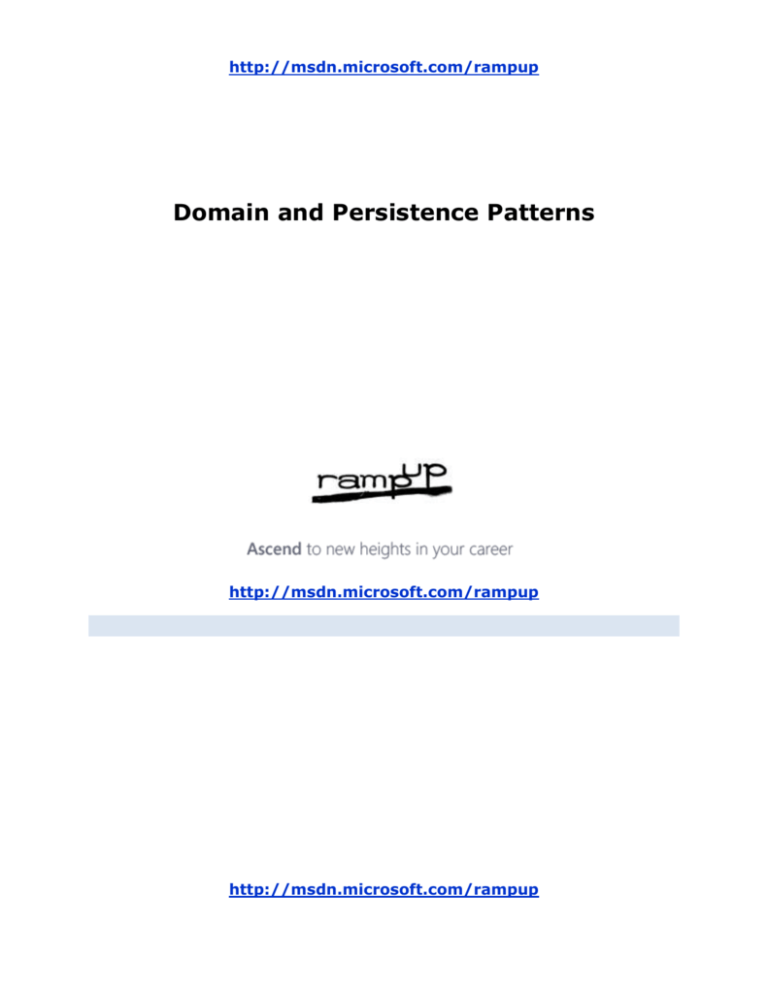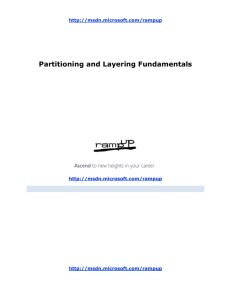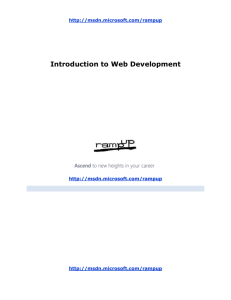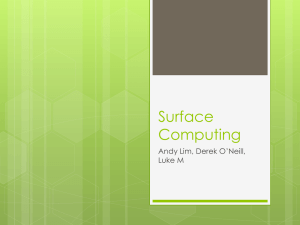Two Basic Types of Patterns
advertisement

http://msdn.microsoft.com/rampup
Domain and Persistence Patterns
http://msdn.microsoft.com/rampup
http://msdn.microsoft.com/rampup
http://msdn.microsoft.com/rampup
CONTENTS
Two Basic Types of Patterns ..........................................................................................................................................3
Isolating Database Logic ................................................................................................................................................5
Data Mapper Pattern .................................................................................................................................................5
Repository Pattern .....................................................................................................................................................6
Summary ........................................................................................................................................................................7
http://msdn.microsoft.com/rampup
http://msdn.microsoft.com/rampup
TWO BASIC TYPES OF PATTERNS
Now we can begin to evolve our application.
There are two fundamental types of patterns: design patterns, and business logic or
domain1 patterns.
Design patterns transcend any particular application. They might be functional, constructive,
or behavioral. The factory pattern could be used, for example, where appropriate, in any
application that needed to control the construction of classes or objects.
Business logic patterns reflect the type of application being built. For example, customers
and orders are related in a certain way because that is how a particular company treats the
relationships between customers and orders. Domain patterns emerge out of domain driven
design.2 Since our sample app is generic, we cannot really discuss business logic patterns.
Nonetheless, it is important to understand the distinction, and for you to think about
patterns for your particular area of industry expertise. Nonetheless, design patterns and
interface based design can be used within the domain model to partition and layer the
domain model.
We can, however, describe patterns to organize the business logic. Fowler3 describes three
architectural patterns to organize the domain logic: Transaction Script, Domain Model, and
Table Module.
Transaction Script is probably familiar to everyone. The application takes the user input,
processes the input, stores the result, and often displays some sort of result to the user.
There is a one-to-one correspondence between user actions and application functionality.
The code that writes to the database is usually very straight-forward.
The problem with Transaction Script is that as the business logic becomes more complex,
the processing becomes too complicated. If the various user actions share multiple
complicated processing paths, with multiple options within each path, the code logic in
1
Here is a good example of how words are overloaded in the software literature. Domain driven design refers to
determining the proper abstractions to use in a software application. These abstractions are often called the
domain model. Fowler (see footnote 3), uses the term domain model pattern or layer to refer to where a complex
set of objects is used to implement the domain model. As we will discuss shortly, there are other ways to
implement the domain model. Fowler distinguishes between Domain Logic and Domain Model pattern which can
be quite confusing.
2
Eric Evans, Domain Driven Design, and Jimmy Nilsson, Applying Domain-Driven Design and Patterns are two good
books that discuss domain driven design.
3
Martin Fowler, Patterns of Enterprise Application Architecture, Chapters 2 and 9
http://msdn.microsoft.com/rampup
http://msdn.microsoft.com/rampup
Transaction Script becomes very convoluted. Suppose adding a customer required finding
out what kind of customer it is depending on credit rating, types of products they were
interested in buying, their geographic area, and characteristics such as size, and their own
customers. Other user actions might want to share the same functional units. Using a rich
set of objects to organize the domain layer becomes much more attractive than procedural
logic.
Both the Domain Model pattern and the Table Module pattern use objects, but they use
those objects in a very different way. If there is a direct correspondence between the tables
in the relational database and the user actions, a Table Module pattern can be a very
attractive approach. Every class corresponds to a conceptual table in the database 4, and a
record or data set can be used to read and write to the database. Many UI widgets can work
with record or data sets directly.
Not all applications have this simple relationship with database tables. Evolving the
application can be more complex. When you use a Table Module pattern, you lose the full
power of object oriented programming techniques. You also have a closer coupling between
the business logic and the data layer. For example, as you get multiple order types, the
Table Module pattern will have one class to handle all the orders, each order would be
identified by an id.
The Domain Model pattern uses classes to model the entire business logic. We can then use
the technique of interface based polymorphism discussed in the first unit to partition, layer,
and evolve the application. In the previous order type example, each order type would be
modeled with a separate class. Each order would be separate object. Hence, it would be
easier to separate out different ways of handling different orders, and factor shared
functionality in shared classes that use these different order types as interfaces.
The Domain Model does not come without a cost. Complicated object models often do not
map well to relational database models. In a relational database, all the data is available to
do joins and unrestricted operations. There is no encapsulation.5 Data is tightly coupled
together by the schema. Only a limited number of operations are available. Objects have a
high degree of encapsulation. With no schema, each object can define its data and behavior
independently.
This can complicate query logic, and make writing ad-hoc queries difficult Object relational
mapping, as will be discussed in this unit, can make this job easier, but does not remove
the problem entirely.6
4
A conceptual table means that the business logic code views the data from the database as a single table. The
data coming back or being stored might actually be the result of a join, or some other database operation.
5
Views are not used for programming language style encapsulation.
6
See Ted Neward’s famous blog post on ORM as the Vietnam of Computer Science for a good discussion of the
problem even if you find his analogy overdone.
http://msdn.microsoft.com/rampup
http://msdn.microsoft.com/rampup
The decision of which to use obviously depends on your application’s characteristics. We will
work through the remainder of these units as if we had a domain model.
Why?
First, unless you know that your application is going to stay simple, the domain model
approach will allow your application to evolve. Simple domain models will have few, if any at
all, real object-relational mismatches. Changing from a Transaction Script or Table Module
pattern to a Domain Model pattern is difficult. The code conversion can be complex, and
programmers who start down the Transaction Script or Table Module path often do not
understand how to use a Domain Model pattern. Complex domain models generally have
benefits that outweigh the object relational mismatch unless end-users write a lot of ad-hoc
queries. Given those benefits, for pedagogical purposes we will assume a Domain Model
pattern. How to write a domain model is beyond the scope of this set of units. Footnote 2
has two good references on the topic.
ISOLATING DATABASE LOGIC
One of the most important isolation layers in an application is between the domain model
code and the code that retrieves data from a data store. Usually this data store is a
relational database. With this isolation, you can modify the business logic without impacting
the database storage and retrieval code, and you can modify the database storage and
retrieval code without changing the business logic.
The set of patterns that accomplish this task are called persistence patterns. We shall focus
on two of these persistence patterns: Data Mapper and Repository. The Data Mapper
pattern7 keeps the logic and database layers independent while moving data between the
database and the objects. Our choice of this pattern was largely dictated by our decision to
use a domain model.8 Object Relational Mapping (ORM) products implement the Data
Mapper pattern. Many of them allow for object queries that can be used in a similar fashion
to SQL queries. They also provide data transactions at the object level. With these and
other features they can alleviate the object-relational mismatch.
DATA MAPPER PATTERN
To give you an idea of how the Data Mapper pattern works we have implemented a very
simple object relational mapping layer in our application. To keep things simple we are not
going to implement features such as lazy loading, identity maps to see if objects are already
loaded, or reflection to provide complete independence between the domain model and the
data mapper. An ORM can also pull in an object tree. In a real application you would use a
product that provides these features rather than create your own. 9
7
This is Fowler’s name for the pattern.
8
As noted in the last section, this is a simulation.
9
See http://ayende.com/Blog/archive/2006/05/12/25ReasonsNotToWriteYourOwnObjectRelationalMapper.aspx
http://msdn.microsoft.com/rampup
http://msdn.microsoft.com/rampup
Our data mapper is based on a simple interface: ICustomerDataMapper which provides just
three primitive operations: delete, save, list. Save handles both creating a new instance and
updating an existing instance.
public interface ICustomerDataMapper
{
void Delete(ICustomer customer);
IList<ICustomer> GetCustomers(IList<int> ids);
void Save(ICustomer customer);
}
The interface is implemented in the file CustomerDataMapper.cs. Interfaces are used as
parameters to the data primitives. They are not bound to any particular implementation of a
customer, or how the data stored with the customer is generated. The domain layer also
has no knowledge of how the data is stored. Right now, data is stored in SortedList
instances. Latter we will use a relational database with no need to change the domain
model.10
Notice that the CustomerManager constructor takes an ICustomerDataMapper interface:
public CustomerManager(ICustomerDataMapper dm)
This technique is called inversion of control which we will discuss in the next unit. Instead of
having the CustomerManager create an instance of an object that implements the
ICustomerDataMapper interface, the instance is associated with the CustomerManager. The
code in the CustomerManager implementation uses this interface. The CustomerManager
implementation is not bound to any particular DataMapper implementation.
REPOSITORY PATTERN
Applications need a mechanism to find existing objects. Our DataMapper layer maps objects
to relational tables. Hence we need a query mechanism that queries objects, not relational
tables. This is what the repository pattern does.
Our example has a very trivial example of a repository pattern to illustrate how it would
work. Most ORMs implement some form of repository.
Our Criteria class represents the simple criterion used in our repository queries. We specify
an operator and an operand for the query. The operators can be “All”, “Id”, or “Name”
depending on whether we want all instances, query based on id or name. The operand
represents the value used in the query. For example if I want the customer whose Id is 4,
the operator would be “Id” and the operand would be “4”.
for a good explanation why you would never write your own ORM.
10
Fowler has a more detailed example of a DataMapper.
http://msdn.microsoft.com/rampup
http://msdn.microsoft.com/rampup
public class Criteria
{
public string Operator { get; set; }
public object Operand { get; set; }
}
The Repository’s Query method returns a collection of objects.
The Repository uses the DataMapper in its implementation. Again, an interface is passed
into the Customer Repository constructor using inversion of control.
public CustomerRepository(ICustomerDataMapper dm)
Since we are using interface based design, it makes it easy to replace our SortedList based
implementation with a relational based implementation of the DataMapper.
Using the repository pattern allows developers to construct queries in terms of the objects
they are using, without having to understand the details of how the database is
implemented or the intracies of whatever SQL dialect the database uses. Even in our
simplistic implementation, asking for a customer brings back the related order. The
repository pattern allows the developer to think in terms of the domain objects with which
they are programming. They get back a fully instantiated chain of the objects they need
without having to worry about how to reconstitute them from the data store
implementation.
SUMMARY
While domain patterns are industry specific, the idea of separating the business logic from
the way data is stored in the database is fundamental.
We have used interface based design to look at two key persistence patterns: DataMapper
and Repository. While these are not the only two persistence patterns, they illustrate two
critical elements in any data hiding layer: hiding the details of the database implementation,
and providing data access in terms of the programming concepts and abstractions used in
the business logic layer.
http://msdn.microsoft.com/rampup











